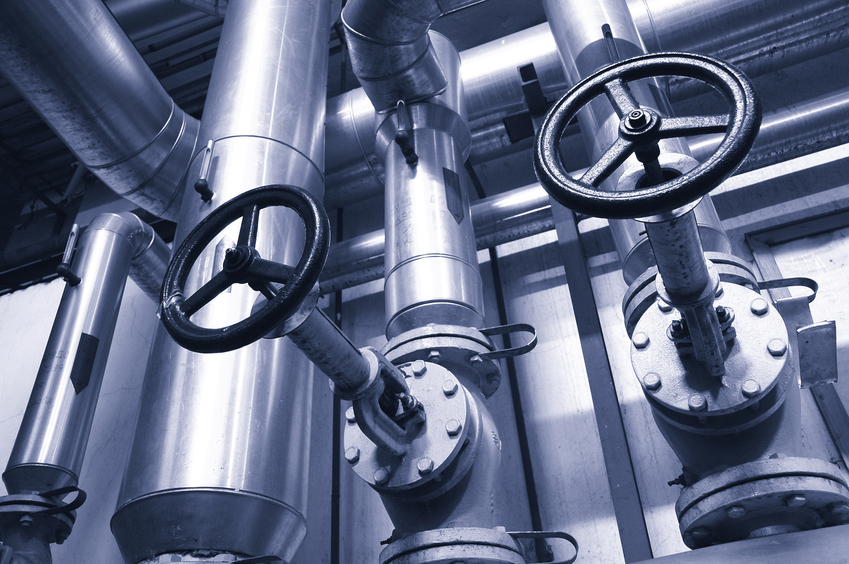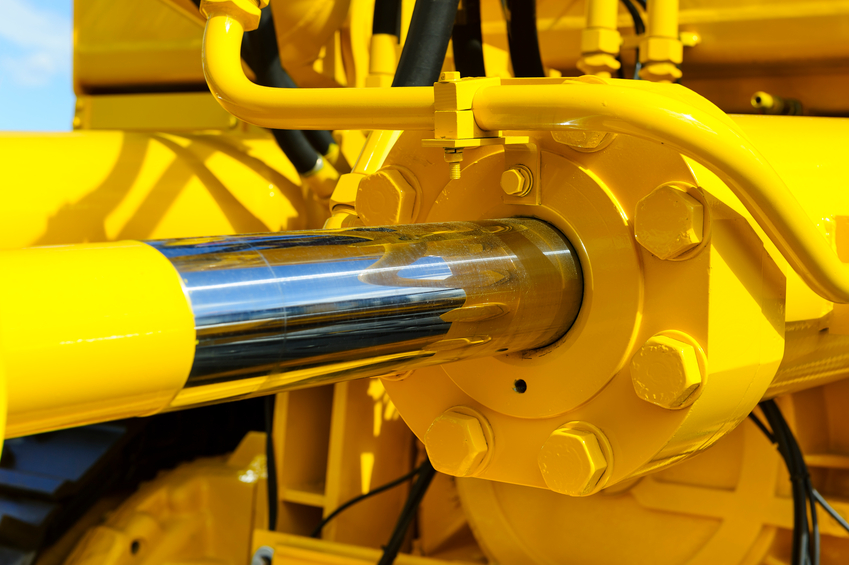Fluid Power/Hydraulics 24 PDH Discount Package
Fluid Power (Part 1) - Hydraulic Principles (M04-016)
Fluid Power (Part 2) - Hydraulic Power Units (M06-009)
Fluid Power (Part 3) - Hydraulic Components (M06-010)
Overview of Steam Traps (D04-001)

This online engineering PDH course provides an overview of control valve with emphasis on the sizing and selection. Selection of the proper valve involves a thorough knowledge of the process for which it will be used. When implementing a control valve into a process, one must consider not only the appropriate type of valve and its material of construction, but also the correct sizing to ensure it performs its designated task without any adverse occurrences in the system.
Control valves are imperative elements in any system where fluid flow must be monitored and manipulated. A complete control valve is made of the valve itself, an actuator, and, if necessary, a valve control device. The actuator is what provides the required force to cause the closing part of the valve to move and the valve control devices keep the valves in the proper operating conditions; they can ensure appropriate position, interpret signals, and manipulate responses.
This 4 PDH online course is intended for mechanical, instrumentation and process engineers involved in sizing, selecting and applying process control valves.
This PE continuing education course is intended to provide you with the following specific knowledge and skills:
- Differentiating between various types of valves and the benefits of each
- Understanding the operation of control valve in a control loop
- Learning how to evaluate and apply actuators and positioners for specific applications
- Understanding the basic hydraulics and the relationship between the Cv, flow rate and pressure drop
- Learning how to size valves for any flow condition likely to be found in a process plant
- Learning how to select the proper valve characteristic for a given process
- Understanding how the installed characteristics can match closely to the inherent characteristics
- Knowing the methods to address system performance issues such as cavitation, flashing and chocked conditions
- Understanding the factors influencing the selection of control valves
In this professional engineering CEU course, you need to review the course document titled "Control Valves Basics - Sizing and Selection".
Upon successful completion of the quiz, print your Certificate of Completion instantly. (Note: if you are paying by check or money order, you will be able to print it after we receive your payment.) For your convenience, we will also email it to you. Please note that you can log in to your account at any time to access and print your Certificate of Completion.

This online engineering PDH course provides an understanding of basic hydraulics principles and presents an overview of the fluid power system, and introduces both Pascal's Law and Bernoulli's Principle.
Most modern machinery today uses fluid power principles to do work so as to make our lives easier. Think about your car's brakes and how, by stepping on the brake pedal, you apply stopping pressure on the brakes on all four wheels. The ease with which we drive and steer our cars today is because of fluid power. You see fluid power at automobile service centers lifting the cars so that mechanics can work underneath them, and many elevators are hydraulically-operated using the same technique. There are numerous such applications that rely on fluid power that are obviously very adaptable, but how do they actually work?
This 4 PDH online course is applicable to mechanical engineers, design professionals, service technicians, operational & maintenance personnel, and facility engineers who are interested in gaining a better understanding in the hydraulic principles of fluid.
This PE continuing education course is intended to provide you with the following specific knowledge and skills:
- Learn the behavior of liquids at rest and the factors affecting transmission of forces through liquids
- Describe the fluid properties such as density, viscosity, flow rates, velocity, temperature, pressure, head and their relationships
- Learn Pascal's law and describe pressure and force in fluid power systems
- Learn the behavior of liquids in motion and the factors involved in flow
- Learn hydraulic principles - calculation of required pressure, required flow and required power
- Understand the Bernoulli's principle and learn how to calculate the fluid velocity or flow rate in a specified fluid system using the continuity equation
- Understand the relationship of force, pressure and head
- Understand the operation of basic hydraulic components and their application in hydraulic jacks and hydraulic brakes
- Learn the quality of fluids acceptable for hydraulic systems
- Learn the safety precautions when handling potentially hazardous fluids
In this professional engineering CEU course, you need to review Chapters 1, 2 and 3 of the Naval Education and Training Materials (NAVEDTRA 12964), Fluid Power as follows:
- Chapter 1: Introduction to Fluid Power
- Chapter 2: Forces in Liquid
- Chapter 3: Hydraulic Fluids
Once you complete your course review, you need to take a multiple-choice quiz consisting of twenty (20) questions to earn 4 PDH credits. The quiz will be based on Chapters 1, 2 and 3 of this NAVEDTRA publication.
Upon successful completion of the quiz, print your Certificate of Completion instantly. (Note: if you are paying by check or money order, you will be able to print it after we receive your payment.) For your convenience, we will also email it to you. Please note that you can log in to your account at any time to access and print your Certificate of Completion.

This online engineering PDH course provides general information on the types and applications of hydraulic prime movers such as rotary pumps, gear pumps, screw pumps and piston pumps along with the network of valves, piping and fittings. It also discusses several types of seals and packing used in fluid power systems.
Fluid systems are utilized in many engineering systems like machine tools, heavy machinery, chemical processes, automotive equipment, aircraft, missiles, and space vehicles. All fluid systems involve the use of power unit comprising of pumps, valves, piping, tubing, and hoses used to convey fluid under pressure.
This 6 PDH online course is applicable to mechanical engineers, design professionals, service technicians, operational & maintenance personnel, and facility engineers who are interested in gaining a better understanding in the hydraulic power units of fluid.
This PE continuing education course is intended to provide you with the following specific knowledge and skills:
- Learn the various classification of pumps such as non-positive displacement, positive displacement, fixed displacement, variable displacement, fixed delivery, variable delivery, constant volume and others used to describe pumps
- Understand the different types of lines including rigid piping, semi rigid tubing and flexible hoses used to carry fluids under pressure
- Understand the selection criteria of defining lines that include material, ID, and wall thickness
- Learn the methods of preparation of pipes and tubing including cutting, bending, flaring
- Understand how to select and identify flexible hoses, and learn how to determine the shelf life of hoses using cure date
- Learn the various types of fittings and connectors used in hydraulic system piping including threaded connections, flange connectors, welded and brazed connectors, manifolds and quick disconnect couplings
- Understand the classification, types, and operation of valves used in the control of flow, pressure, and direction of fluids
- Understand the types and purposes of sealing devices used in fluid power systems, including the different materials used in their construction
In this professional engineering CEU course, you need to review Chapters 4 through 7 of the Naval Education and Training Materials (NAVEDTRA 12964), Fluid Power as follows:
- Chapter 4: Pumps
- Chapter 5: Fluid lines and fittings
- Chapter 6: Valves
- Chapter 7: Sealing devices and materials
Once you complete your course review, you need to take a multiple-choice quiz consisting of thirty five (35) questions to earn 6 PDH credits. The quiz will be based on Chapters 4 through 7 of the Naval Education and Training Materials (NAVEDTRA 12964), Fluid Power.
Upon successful completion of the quiz, print your Certificate of Completion instantly. (Note: if you are paying by check or money order, you will be able to print it after we receive your payment.) For your convenience, we will also email it to you. Please note that you can log in to your account at any time to access and print your Certificate of Completion.

This online engineering PDH course introduces the theory, concepts and modes of operation of hydraulic components. It also provides an understanding of how common hydraulic components function and interact with each other.
Fluid systems involve the use of fluids to transmit and multiply force. The basic hydraulic unit for this purpose makes use of various hydraulic components such as reservoirs, actuators, filters and accumulators. It also involves the use of diverse types of controls including pressure control and valves, flow control, directional control and solenoids.
This 6 PDH online course is applicable to mechanical engineers, design professionals, service technicians, operational & maintenance personnel, and facility engineers who are interested in gaining a better understanding in the hydraulic components of fluids.
This PE continuing education course is intended to provide you with the following specific knowledge and skills:
- Learn the operation of devices used to measure and regulate the pressure of fluids and to measure the temperature of fluids
- Describe the functions of reservoirs, strainers, filters, and accumulators, and their uses in fluid power systems
- Learn the types and operation of actuators used to transform the energy generated by hydraulic systems into mechanical force and motion
- Learn about pneumatics, the characteristics and compressibility of gases and the most commonly used gases in pneumatic systems.
- Learn the safety precautions and the potential hazards of compressed gases
- Understand the types of system diagrams encountered in fluid power systems
- Understand how hydraulic components are combined to form and operate together as a system
In this professional engineering CEU course, you need to review Chapters 8 through 12 of the Naval Education and Training Materials (NAVEDTRA 12964), Fluid Power as follows:
- Chapter 8: Measurement and pressure control devices
- Chapter 9: Reservoirs, strainers, filters, and accumulators
- Chapter 10: Actuators
- Chapter 11: Pneumatics
- Chapter 12: Basic diagrams and systems
Once you complete your course review, you need to take a multiple-choice quiz consisting of thirty (30) questions to earn 6 PDH credits. The quiz will be based on Chapters 8 through 12 of the Naval Education and Training Materials (NAVEDTRA 12964), Fluid Power.
Upon successful completion of the quiz, print your Certificate of Completion instantly. (Note: if you are paying by check or money order, you will be able to print it after we receive your payment.) For your convenience, we will also email it to you. Please note that you can log in to your account at any time to access and print your Certificate of Completion.

This online engineering PDH course provides an overview of this essential component and discusses the operation, selection, installation and maintenance criteria of various steam traps for different applications.
No steam system is complete without this crucial component "the Steam Trap". This is the most important link in the condensate loop and the steam system, as it connects steam usage with condensate return. By definition, a steam trap 'purges' condensate, as well as air and other incondensable gases, out of the system, allowing steam to reach its destination in as dry condition as possible to perform its task efficiently and economically. It is important that a steam trap must trap or hold back steam and not allow it to pass along with condensate or air. If not maintained or applied properly, it can result in significant energy wastage.
This 4 PDH online course is aimed at mechanical engineers, chemical engineers, process engineers, and system design engineers working in power, oil and gas, chemical, metal and mining, manufacturing and engineering industries. It is also intended for energy auditors and operation and maintenance personnel.
This PE continuing education course is intended to provide you with the following specific knowledge and skills:
- Understanding the functions of a steam trap
- Learning about the various types of steam traps; their advantages and disadvantages
- Understanding the selection criteria for the steam traps
- Knowing the system design considerations and the installation aspects
- Understanding the performance testing of steam traps
- Learning about the maintenance aspects and energy saving opportunities
- Understating the applicable codes and standards
In this professional engineering CEU course, you need to review the document titled "Overview of Steam Traps".
Upon successful completion of the quiz, print your Certificate of Completion instantly. (Note: if you are paying by check or money order, you will be able to print it after we receive your payment.) For your convenience, we will also email it to you. Please note that you can log in to your account at any time to access and print your Certificate of Completion.